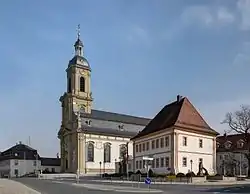Wiesentheid
Wiesentheid is a municipality in the district of Kitzingen in Bavaria in Germany.
Wiesentheid | |
|---|---|
 Church of Saint Maurice and the rectory | |
 Coat of arms | |
Location of Wiesentheid within Kitzingen district  | |
 Wiesentheid  Wiesentheid | |
| Coordinates: 49°48′N 10°21′E | |
| Country | Germany |
| State | Bavaria |
| Admin. region | Unterfranken |
| District | Kitzingen |
| Government | |
| • Mayor | Werner Knaier (CSU) |
| Area | |
| • Total | 33.33 km2 (12.87 sq mi) |
| Elevation | 249 m (817 ft) |
| Population (2019-12-31)[1] | |
| • Total | 4,834 |
| • Density | 150/km2 (380/sq mi) |
| Time zone | UTC+01:00 (CET) |
| • Summer (DST) | UTC+02:00 (CEST) |
| Postal codes | 97353 |
| Dialling codes | 09383 |
| Vehicle registration | KT |
| Website | www.wiesentheid.de |
History
It was first mentioned in 918 as "Wisenheida". Mediatization in 1806 brought the former county of Schönborn into the Grand Duchy of Würzburg, along with which it became part of the Kingdom of Bavaria in 1814. The Bavarian Municipal Edict of 17 May 1818 (Gemeindeedikt (de)) formed today's Wiesentheid.[2]
Main sights
- Count's Castle Wiesentheid
- Kanzleistrasse – street with historic administrative buildings
- Schlossparkanlage – castle garden (English)
- catholic Church of Saint Maurice built by Balthasar Neumann
- historic vicarage
- historic town hall
- crucifixion memorial built by Jacob van der Auvera
- historic Mariensäule (memorial of Mother Mary)
Personalities
- Johann Georg Fuchs von Dornheim, (1586-1633), prince-bishop of Bamberg, and fighters for the counter-reformation as well as ruthless sorcerers ("Hexenbrenner").
- Carl Stumpf (1848-1936), philosopher, psychologist and musicologist
References
- "Tabellenblatt "Daten 2", Statistischer Bericht A1200C 202041 Einwohnerzahlen der Gemeinden, Kreise und Regierungsbezirke". Bayerisches Landesamt für Statistik und Datenverarbeitung (in German). July 2020.
- H. Clément: Das bayerische Gemeindeedikt vom 17. Mai 1818. Ein Beitrag zur Entstehungsgeschichte der kommunalen Selbstverwaltung in Deutschland. Diss. Freiburg i. B., 1934.
External links
| Wikimedia Commons has media related to Wiesentheid. |

Wiesentheid Castle of the Counts of Schönborn, built from 1701 for Rudolf Franz Erwein von Schönborn

Portal of castle
This article is issued from Wikipedia. The text is licensed under Creative Commons - Attribution - Sharealike. Additional terms may apply for the media files.
